|
Field caps were worn by all ranks and branches of the regular
Imperial German army and also the Schutztruppe and other overseas
forces.
The cap itself was based on the Prussian army cap of 1842, which was a
rounded cap peaked for officers and senior NCOs and peakless
for other ranks. It was usually made in
the colour of the uniform tunic and had a coloured hatband and piping
around the top edge which denoted the wearer's arm of
service. In the Schutztruppe these colours usually showed
the colony in which the wearer was serving: cornflower blue
for South West Africa, white for East Africa, red for
Cameroon and authorised from 1913, yellow for Togo, green
for New Guinea and pink for Samoa.
The Prussian
army cap of 1842 had a small Prussian cockade in the centre
of the hatband, colonial and overseas troops then usually
wore an imperial cockade black/white/red on their caps.
In the regular German army, officers and
senior NCOs wore caps with black leather peaks while other
ranks had peakless ones. In the glaring sun of the colonies
all ranks wore peaked caps.
Officers caps were authorised with a wire around the inside of
the cap keeping the upper part a stiff round shape, as opposed to the
other ranks peakless caps which often had a shapeless form. Against
regulations many officers removed the wire on active service, which
gave the cap a more casual shape. As with other
items of uniform officers usually wore privately tailored caps made
from better quality materials, in differing shades, with comfortable
linings and more elaborate cockades.
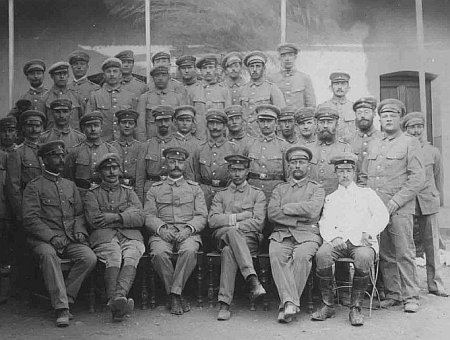
South West African
Schutztruppe wearing the khaki corduroy peaked field cap
with cornflower blue hatbands, note however the doctor in
white tropical uniform seated on the right side wearing a
grey cap with the dark blue hatband of his service.
South West African Schutztruppe
The South West African Schutztruppe first introduced the
field cap to gradually replace the kepi from 1894. It was a
peaked cap made of khaki corduroy matching their uniform
with cornflower blue hatband and piping. From 1897 similar
peaked caps matching the grey cloth home uniform were also
introduced.
East African
Schutztruppe
From 1891 white peaked caps were authorised for German
Officers and NCOs with a cornflower blue hatband. These were
replaced from 1896/7 with peaked caps matching the grey home
uniform with white hatbands and piping. Variations have been
seen in khaki corduroy and field grey.

Two officers of the East
African Schutztruppe training zebra. The white hatbands on
their grey peaked caps are easily distinguishable.
Cameroon Schutztruppe
Initially as in East Africa, white peaked caps were
authorised with a cornflower blue hatband. These were
replaced from 1896/7 with peaked caps matching the grey home
uniform with red hatbands and piping.
Army Officers Seconded
to the Colonies
Army officers seconded from their home units to the
colonies, wore the colony's colours but retained their state
cockade worn below the imperial cockade on the front of
their caps. From 1913 new colony colours were authorised for
officers serving in Togo (yellow), New Guinea (green) and
Samoa (pink).
Colonial Officials
Officials of the Schutztruppe such as doctors, armourer's
and paymasters all wore different coloured hatbands and
piping, sometimes with a heraldic device above the hatband
to denote their different branches of service.
Polizeitruppe
German NCOs and officials of the Polizeitruppe in East
Africa, Cameroon, Togo, New Guinea and Samoa wore white
peaked caps to match their tropical uniforms with a red
hatband. From 1913 new colony colours were authorised for
those serving in Togo (yellow), New Guinea (green) and Samoa
(pink).
South West African
Landespolizei
From 1907, the South West African Landespolizei wore dark
khaki caps to match their uniforms with green hatbands and
piping.
Marine Infantry
The marine infantry of the Seebataillone wore the standard
Prussian infantry field cap in dark blue, with white hatband
and piping and an imperial cockade. It was peaked for
officers and senior NCOs and peakless for other ranks,
though in China other ranks were able to purchase peaked
caps.
To match the
khaki tropical uniform, a plain khaki cap with a still upper
edge and a black leather peak was introduced. It had an
imperial cockade but had no coloured hatband or piping.
Similarly officers wore plain white peaked caps with their
white tropical uniforms.
For soldiers of
the marine infantry serving on the Western Front in the
First World War peaked and peakless field caps were issued
in field grey to match their uniforms as of 1915. They
retained the white hatband and piping and single imperial
cockade.
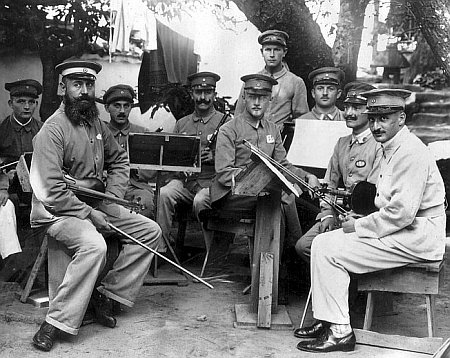
Prisoners of the III.
Seebataillon, Japan 1916. The bearded violin player on the
left wears the dark blue peaked cap with white hatband and
piping while all the other figures wear the khaki cap
East Asian
Expeditionary Corps
The East Asian Expeditionary Corps of 1900 generally wore
the caps of their home units. These were peaked for officers
and peakless for other ranks. They had a state cockade below
the imperial cockade and were made in the colours of their
home uniforms- dark blue for infantry, artillery and
pioneers, pale blue for Bavarian infantry, green for light
infantry and green was also the colour issued to the cavalry
despite their home caps being a variety of colours for each
regiment. Cap bands and piping were red for all infantry and
cavalry and black pied in red for artillery and pioneers.
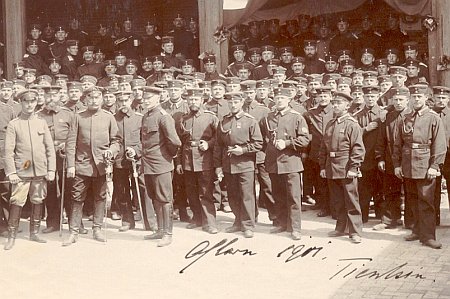
East Asian Expeditionary
Corps, Tientsin 1901. Note the peaked caps for officers and
peakless for other ranks and the use of both imperial and
state cockades.
From August 1900
a plain khaki cap with a stiffened upper edge, black leather
peak and detachable neckshade was authorized. It retained
the state and imperial cockades but had no coloured hatband
or piping. With minor alterations (such as the discarding of
the neckshade and stiffened rim) the cap remained in summer
service with the East Asian force until their disbandment in
1909.
From 1901 state
cockades were dispensed with on all headgear. A new winter
field grey cap was also introduced, peaked for all ranks and
piped in red around the upper edge for all branches of
service. The infantry now had a white hatband, the cavalry
red and artillery and pioneers had black edged in red.
Asienkorps
While many German
units serving on Ottoman fronts in the First World War wore
their home field grey uniforms and caps, khaki caps with an
elongated black leather peak and detachable neckshade were
also issued. On them, both the imperial and state cockades
were worn.

German soldiers with an Arab
Sheik, Palestine c1917. The officer on the left (Hauptmann
Justin) wears a privately purchased officers peaked cap,
while the two soldiers on the left wear the Asienkorps
tropical khaki cap with elongated peaked.
|
|
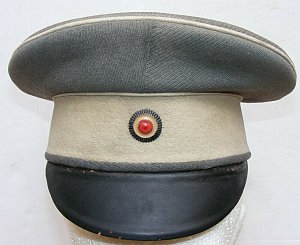
East African Schutztruppe
NCOs grey cap with white hatband and piping
Jeff Nelson Collection
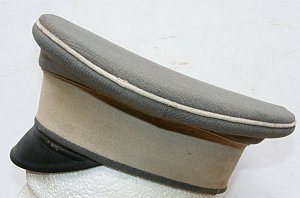
East African Schutztruppe
NCOs Cap
Jeff Nelson Collection
.jpg)
South West African
Schutztruppe
Officers privately purchased khaki field cap with
cornflower blue hatband and piping
Internationales Maritimes Museum Collection, Hamburg
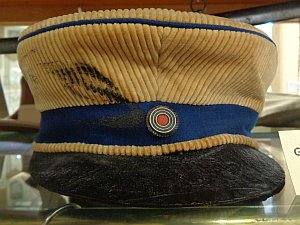
South West African Schutztruppe
NCOs corduroy field cap with
cornflower blue hatband and piping
Swakopmund Museum
Collection
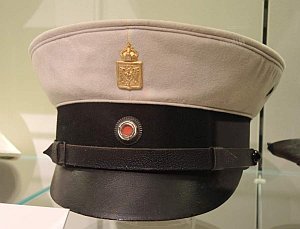
South West African Schutztruppe
Saddler's Cap, with black hatband and
heraldic gold shield above the cockade
Internationales Maritimes Museum
Collection, Hamburg
.jpg)
East African Schutztruppe
Privately purchased officers cap in khaki corduroy with
matching peak, white hatband but no upper piping.
Internationales Maritimes Museum Collection, Hamburg
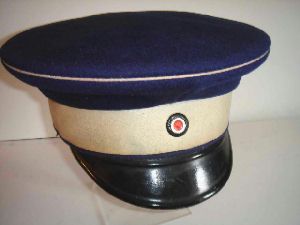
Marine Infantry
Other ranks blue peaked cap with
white hatband and piping.
Doppler Collection

Interior of the Marine
Infantry Other Ranks Cap
Doppler Collection
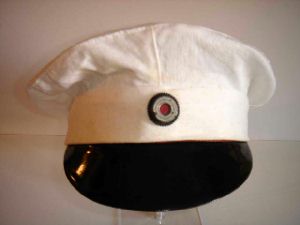
Marine Infantry Officers White Tropical Cap
Doppler Collection
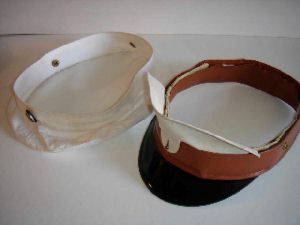
Marine Infantry Officers
White Tropical Cap
How the white section detaches for ease of washing
Doppler Collection
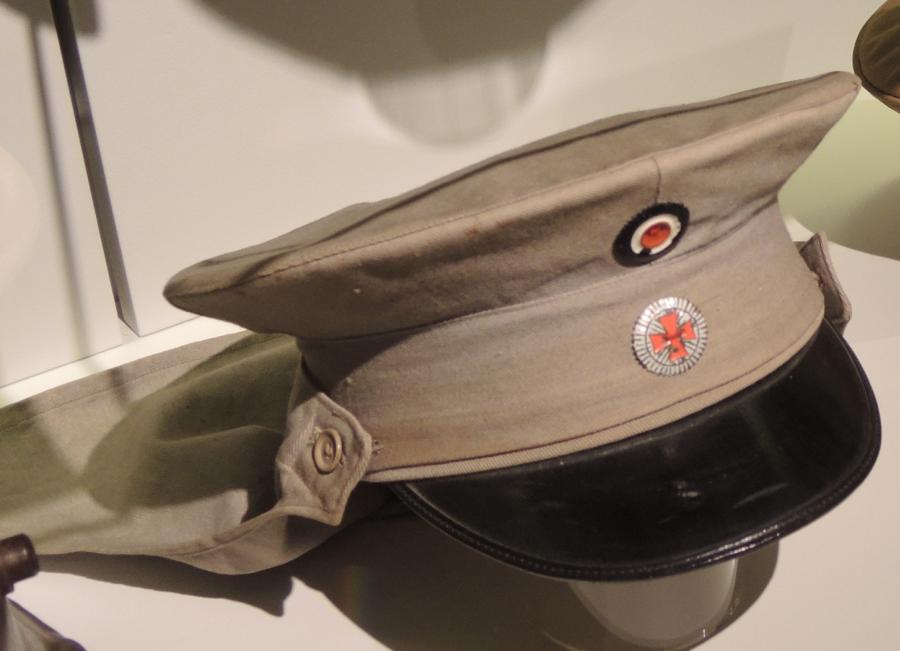
East Asian Expeditionary Force
Other ranks 1900 tropical peaked cap with neckshade and
Hamburg state cockade
Internationales Maritimes Museum Collection, Hamburg
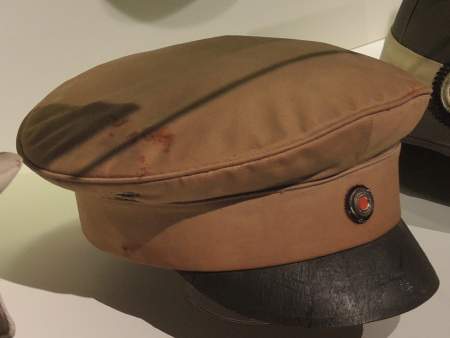
East Asian Occupation Brigade
NCOs tropical peaked cap from 1901
Internationales Maritimes Museum Collection, Hamburg

Freikorps Schwarze Jäger
Officers modified M1915 naval infantry field grey peaked
cap
Internationales Maritimes Museum Collection, Hamburg |